Table of Contents
Getting inbound lead routing properly is crucial for any SaaS company, no matter how experienced you are with lead routing.
First, let’s take a step back and look at the basics of different routing strategies and when to apply them.
What is Inbound Lead Routing?
When a prospect fills out a form and submits it, inbound lead routing takes place in the background, but before it reaches a sales representative.
The distribution of leads to the sales staff will be more equitable as a result of this.
You have the option of using a manual or automatic process, depending on how many incoming leads you receive.
Why It’s Important to Get Inbound Routing Right?
Having your sales team well-fed and empowered to close deals depends on perfecting your inbound operations.
There are several aspects of the inbound process, but lead routing is the most contentious.
Who handles lead routing in Your Business?
The truth is that your go-to-market approach and the structure of your sales force will have a significant impact on which lead routing mechanism you choose.
To find out who in my network is in charge of lead routing and why I recently conducted a survey on LinkedIn. The outcomes were as follows:
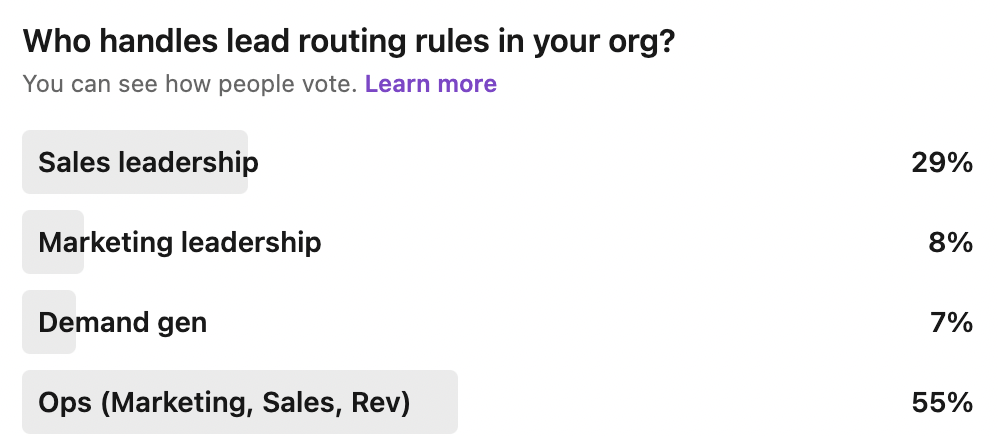
And the following are some of the explanations given:

It should go without saying that sales have a say in how leads created by marketing are allocated across the organization.
Whenever it comes to lead routing, the technologies you employ and how they interact will have a major impact on what’s achievable thanks to sales ops, advertising ops, or revops, thus the operations unit of the company should own execution.
Lead Routing Techniques
As a publication that supports hundreds of businesses set up lead routing, we’re here to demonstrate for you the most popular ways to do this correctly.
Geographical territory
Geographic lead routing is used by companies for several reasons. For the most part, the corporation has an external sales role where salespeople go to their geographical zone.
Assigning accounts to reps in a certain region (such as the East Coast of the United States, the Mountain West of the United States, or EMEA) makes logistical sense in this situation.
For inside sales employees who may be interacting with clients in different time zones, making scheduling easy is another factor.
The size of the company
Customers can be routed based on the number of employees they have, which is another typical routing approach.
As an illustration, consider the following:
- SMB (1-50 employees)
- Mid-Size Company (51-200 employees)
- Enterprise (251-5,000 employees)
As a firm grows, you may find that your product line or value add changes.
Reps that specialize in a certain market segment can communicate more effectively about the benefits your solution brings to that market.

Vertical integration in the industry
To effectively service a certain part of the market, several organizations separate their sales teams based on industry verticals.
The value add and product-specific offering, for example, change depending on the industry vertical you serve if you provide a B2B marketing solution. Here are a few examples:
- SaaS
- E-commerce
- Travel & Tourism
- Finance
- Insurance
By organizing your sales force around these verticals, your salespeople will gain vertical expertise and develop connections with their colleagues.

Line of products
Leads are assigned to your sales team based on the different items you sell. This is known as routing by product line.
This strategy works best for businesses that sell a variety of goods under their brand.
Think about a SaaS company that sells two separate products that customers can choose from. Because you work for a creative company, we’ll call them Product A and Product B. Consider dividing your sales force into Product A and Product B representatives so that each can focus on a certain service or product.
The other side is that plenty of businesses offer a specific platform with a variety of functions, but the platform as a whole has to be acquired. Because you just sell one item, it’d be pointless to distribute leads based on product lines.
Round-robin vs. account ownership
Leads can be distributed in any of the above-mentioned routing scenarios based on predetermined account ownership or by round-robin.
When a rep owns an account in your organization’s CRM, they are said to have account ownership. As a result, each inbound lead affiliated with a certain account will be automatically assigned to that salesperson.
Round-robin, on the other side, corresponds to the assignment of leads to a queue in which the recipients alternate every time they are called. Depending on characteristics like tenure or performance, this can be weighted equally or differently depending on how long the employee has been there.
Let’s imagine you wish to distribute leads across representatives assigned to a particular product line in a round-robin fashion. If a lead comes in for a certain product line, you may have a lineup of 3 reps who support it. That lead is then given to the next rep in the queue.
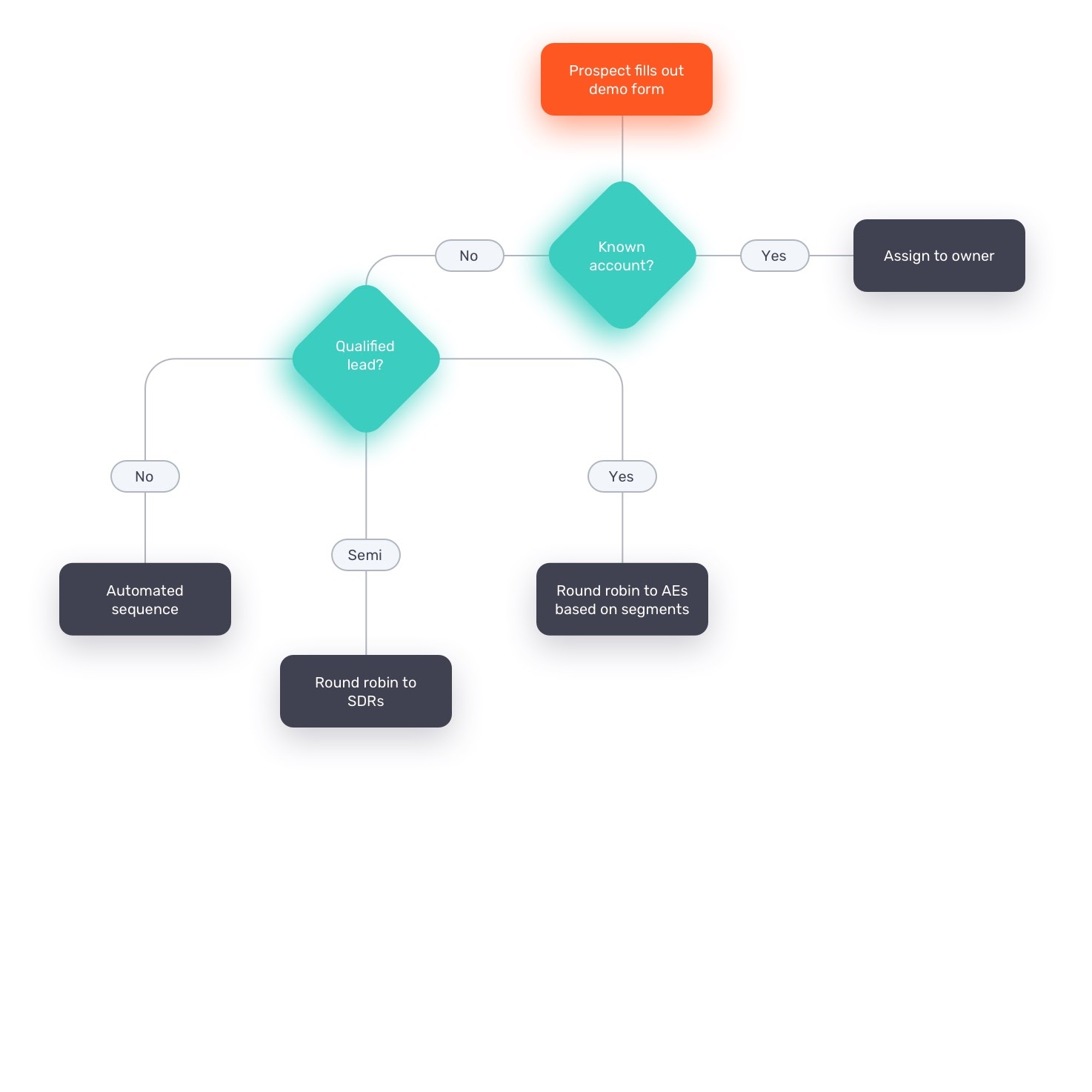
Named accounts
A named account is one from a specified list of accounts that your business is pursuing. These accounts are often kept in a spreadsheet or your customer relationship management system (CRM).
You can import huge accounts lists based on relatively loose criteria, such as the size of the company or industry vertical, into your database in the early stages of doing operations before your ICP is clearly defined.
Reps can then cherry-pick prospects for outbound efforts while inbound leads are rounded-robin distributed.
This approach of allocating named accounts to salespeople can help you focus your marketing and sales efforts on a smaller, established set of customers who are a good fit as your company grows and its ICP becomes more clearly defined.
AE vs. SDR
When deciding on a lead routing strategy, another factor to consider is who will make the first contact with your prospect after they raise their hand.
According to the sales cycle, inbound leads in most B2B SaaS firms are first screened by SDRs and then passed on to Account Executives for either a discovery call or a product demo.
However, some businesses completely ignore SDRs when it comes to receiving incoming orders. While this streamlines the prospect’s experience, it can cause AE’s calendars to become overflowing with unqualified meetings instead.
Asking basic questions for clarification on your lead generation form will help combat this. Some friction can help filter out poor leads and reserve AEs’ calendar space for qualifying meetings, even though it’s a great practice to make these meetings as brief as possible.
However, this can be automated. To automatically analyze and route inbound leads, you might utilize a scheduling tool like Chili Piper.
Examples of Real-World Inbound Success
Aquila
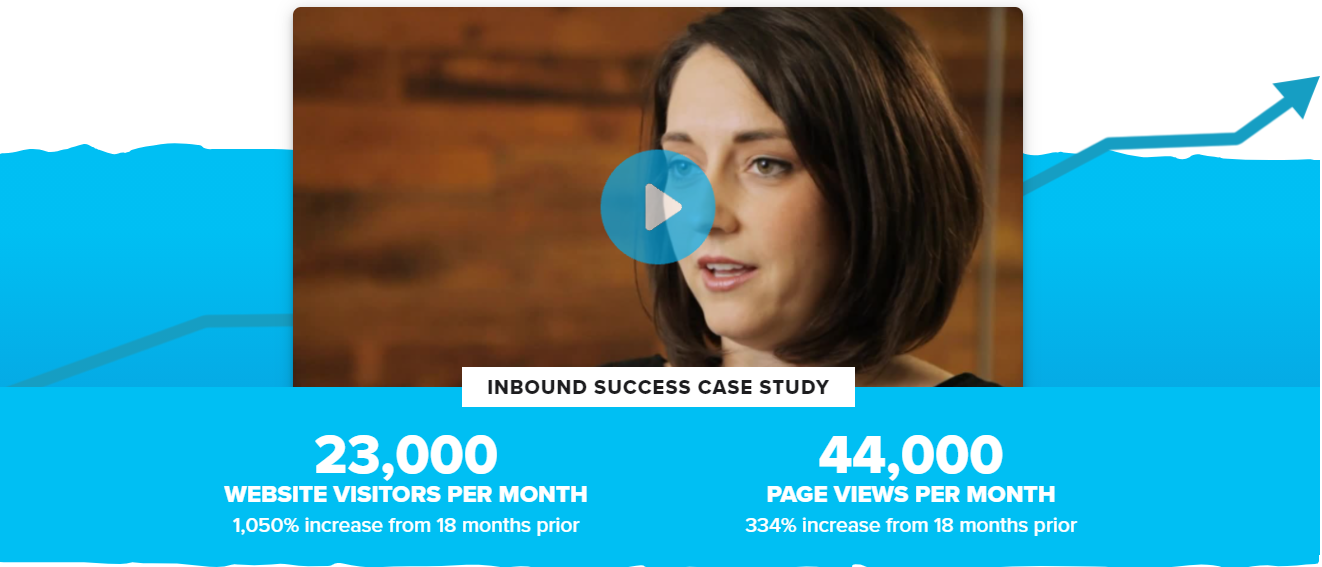
Even if everything goes perfectly, buying a property might be stressful if you’ve never done it before. While you’re signing legal agreements that (hopefully) don’t require you to surrender your first-born child to your realtor, they throw about terms and conditions you’ve never heard before.
Consider how difficult it would be to manage commercial real estate for your small business if you quadrupled the intricacy of that scenario. It’s a horrible experience.
However, you’d still have hundreds, if not thousands, of queries on how the process works, similar to when buying a personal residence. Ideally, a superb source of knowledge would explain everything in plain English rather than using jargon-filled technical words. In a straightforward and easy-to-understand manner, one single reality should answer all of your inquiries about purchasing, leasing, and letting commercial property.
As a result of adopting an inbound marketing strategy, Aquila Commercial has become exactly what it set out to be.
The Strategy
- They play to their abilities. For example, Aquila is an Austin-based company, as opposed to some of the others. And, as they put it on their website’s homepage banner, “No one knows Austin better.”
- As a result, they have a significant competitive advantage in their area. However, how? They used IMPACT partner Marcus Sheridan’s “They Ask, You Answer” methodology to help them with that.
- The chief marketing officer of Aquila and self-described Marcus Sheridan “fangirl,” Kendall Guinn, has been following Marcus’ career for a while. Kendall learned about the They Ask, You Answer method to inbound and content marketing by watching his keynotes at conferences, listening to his podcast, and watching his YouTube videos.
- Her company was resistant to the idea of an inbound culture workshop, but Kendall persisted and did her best to convince them otherwise.
- Aquila enlisted the help of IMPACT as a long-term strategic consultant.
- For the Aquila team to become the finest educators for anyone wishing to unpack the complexities of commercial property, they followed a strict curriculum focused on content marketing, media advertising, and HubSpot software.
- They learned the fundamentals of SEO, including how to produce blog posts and create high-ranking YouTube videos.
The Success
- It had been years since their website’s organic traffic had budged much, averaging slightly around 2,000 unique visitors a month. However, their traffic increased dramatically after they began providing genuinely valuable, simple-to-understand content instead of just two articles and a video every week.
- They saw a 350% rise in organic traffic to 8,700 visits in a year. They saw a 1,050 percent spike in traffic in only one month by the end of February 2019.
- However, in addition to the rivalry, they began to witness a dramatic rise in interest from potential clients.
- Aquila’s website gained 22 new organic visitors in May of 2020. Aquila’s sales team is receiving an average of 200 leads per month as of the first quarter of 2021.
- Aquila’s marketing strategy has included a lot of videos. However, getting their crew to use it wasn’t easy at first.
- Aquila has made a name for itself in Austin’s commercial real estate market.
- Nearly 400,000 people have visited their website, and they’ve created over 4,000 contacts. They’ve also closed 111 deals.
Yale Appliance

There are many well-known kitchen appliance manufacturers, such as General Electric, Whirlpool, and Kenmore that most people are familiar with. If you were asked which firm you believed was the largest online pioneer in the kitchenware market, you’d guess one of those brands.
These firms, each valued at a few billion dollars, should theoretically “own” the digital space.
You may be astonished to hear, however, that the appliance industry’s leading consumer information source is not only not a leading manufacturer, but also not a producer at all.
A regional retail store in Boston, Massachusetts called Yale Appliance is making a killing by providing informative articles, videos, buyer’s manuals, and ebooks that answer the most pressing issues potential purchasers have regarding appliances.
Since 1923, Yale Appliance has sold and serviced household appliances and lighting to Boston residents. Yale Appliance has made it through every economic downturn since the Great Depression in the late 1920s through the Great Recession of 2008.
How, then, does a neighborhood appliance store manage to stay in business for several generations while many of its competitors have been forced to close their doors due to the downturn in the economy?
The answer is quite straightforward:
Rather than looking inward, they started listening to their clients’ complaints and issues as well as their wants and desires.
The Strategy
- When Yale Appliances’ CEO Steve Sheinkopf started a company blog in 2007, he thought it is time to start controlling online conversations about Yale Appliances’ home appliances. The results he was seeing online were pleasing for four years — an expanding social media presence and a consistent (if tiny) increase in monthly visitors.
- He hated traditional outbound advertising but had no choice but to use it in some cases because he had no other option.
- In light of the recession, Steve was compelled to reconsider his business objectives and strategies.
- Steve wanted to investigate more why his inbound marketing plan was not generating the results he desired, so he searched the internet for answers amid these difficult economic times.
- It was while researching HubSpot that he came across the River Pools & Spas case study and decided to contact Marcus Sheridan (partner at IMPACT) to see if an on-site inbound marketing seminar with his staff may assist his company’s inbound marketing efforts to turn around.
- Following several more letters exchanged, Steve decided to invite Marcus to come to his organization and explain the key marketing idea of IMPACT, They Ask, You Answer. Steve appreciated Marcus’ sincere critique of Yale’s content marketing efforts.
- With renewed vigor and a defined direction and attainable goals, the Yale Appliance team began its content marketing plan after the workshop in early 2011.
- New content marketing strategies, including revising the company’s long-term objectives, were all part of Steve’s plan for 2017. It dawned on him that to succeed, he’d have to put the needs of his consumers first, create useful information, and assist customers in their purchase decisions.
- His strategy was to become the “Yelp for kitchen equipment” by concentrating on the “Big 5” content categories.
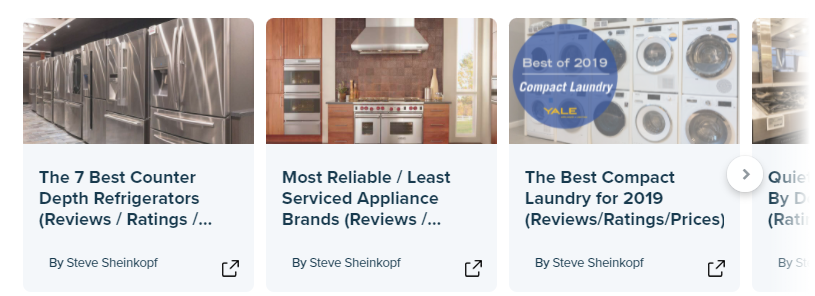
- Steve also adopted content creation as a company-wide policy, including a requirement in the employee handbook for all employees to participate in content creation.
- Yale Appliance’s material was largely written by Steve, even though the company mandated that everyone contribute to content creation — by writing fresh articles, filming videos, or coming up with new ideas.
The Success
- Since 2011, Yale Appliance has seen an increase in web traffic, prospects, customers, and income of approximately 100% per year, averaging up to 800,000 visits per month and generating 8,000 new leads per month with retargeted marketing.
- They’ve had approximately 30 million visitors to their website, generated over 350,000 connections, and closed over 14,000 clients since they started using inbound marketing.
- Yale Appliance has risen to the top of its field just by focusing on and being ready to answer customer questions better than anyone else.
- Yale Appliance has generated $117 million in revenue only from organic channels since implementing inbound marketing, and they’re gearing up to launch a third store.
West Roofing Systems, Inc.
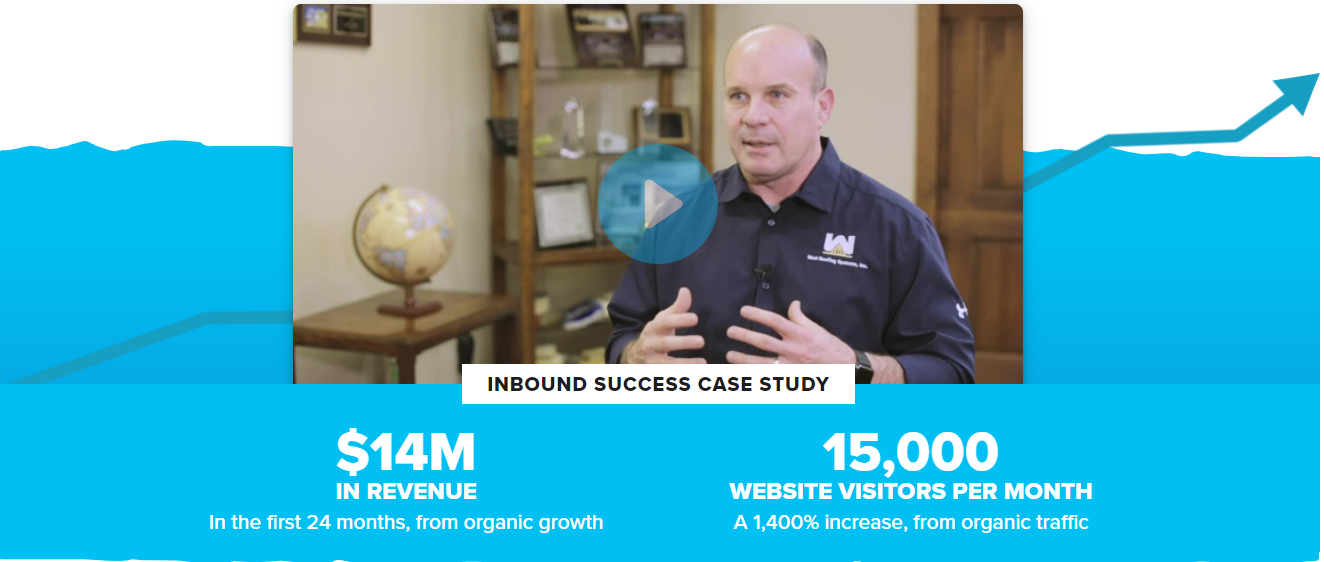
Cleveland-based commercial roofing contractor West Roofing Systems, which is commemorating its 40th anniversary this year, has relied heavily on word-of-mouth recommendations to generate new business. They wanted a change of pace.
When the West Roofing Systems staff intended to separate themselves from the rest of its competition, they revamped their website so that it was focused on teaching customers all things commercial roofing, that is, until a little over two years ago.
When the organic website traffic to West Roofing Systems CEO Jack Moore’s website plateaued, he realized he had a problem on his hands. Moore was well aware that he had to take action.
The Strategy
- For Jack, working with IMPACT was a great way to get his in-house marketing staff up to speed on inbound marketing best practices.
- To get started, we hired a marketing manager who would be responsible for the entire process. After that, they started writing two blog posts a week to address the most frequently asked concerns about commercial roofing.
- No topic was left unanswered, from the issues that prompt building owners to contemplate purchasing a new roof to the extensive descriptions of the various roof devices available to building owners.
- While the number of people visiting their website has increased dramatically in the last two years, getting their sales staff to use the information in sales prospecting has proven to be a significant challenge.
- For the sales team to be successful, the existing material must be used in their process rather than just by the marketing team. The most key instructional content a company has created addresses 80% of the questions most consumers have about a service or product before a sales conversation or appointment, which we recommend sales representatives give their prospects “homework assignments” at various stages in the sales process.
- However, as soon as they overcame the period of adjustment, assignment selling was as easy as pie.
- They’ve also started turning their written material into video content because video has been proven to build trust faster than any other sort of content by the staff at West Roofing Systems in both sales and marketing methods.
The Success
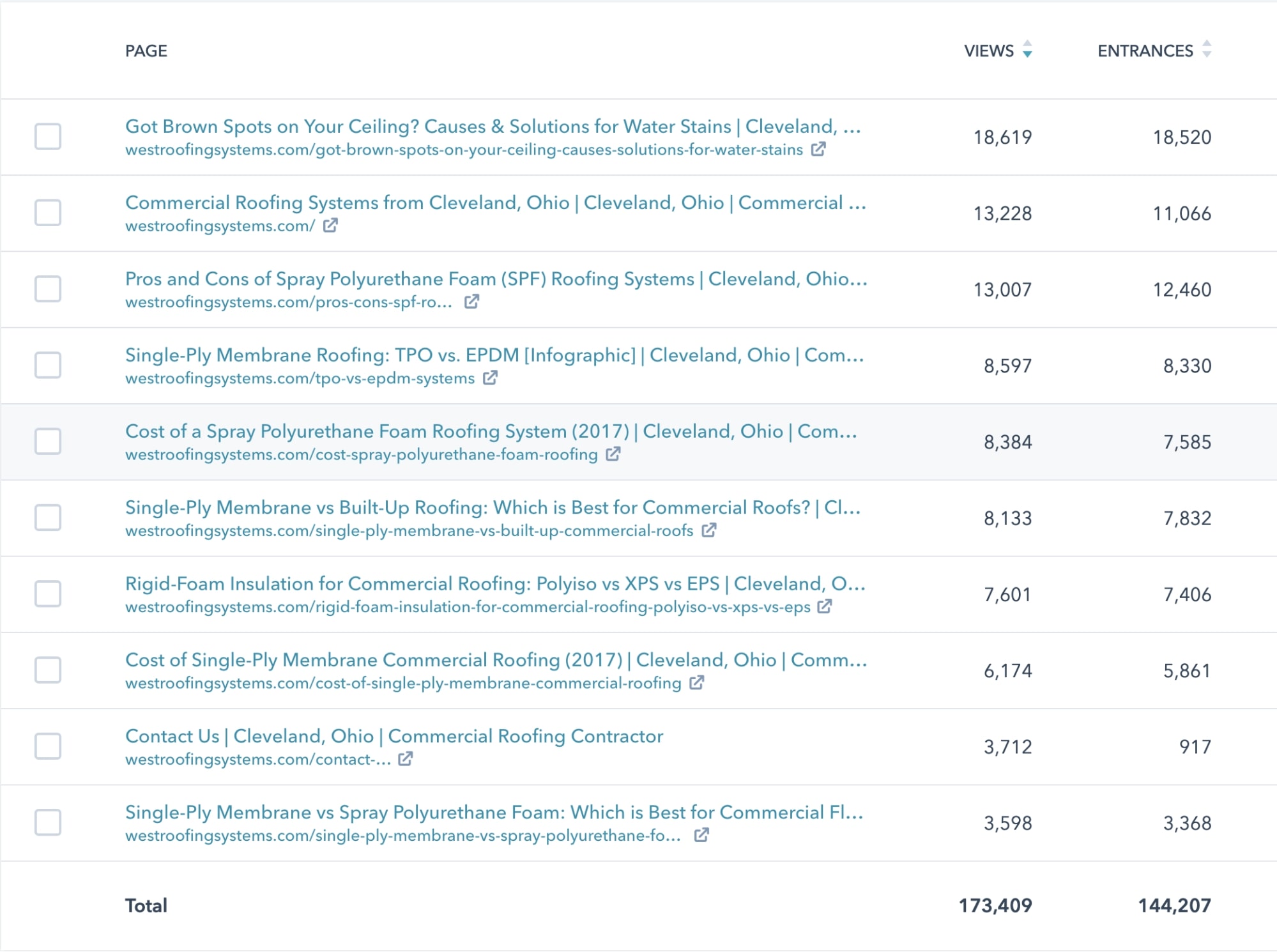
- When they set out to become the finest teachers in their field by thoroughly and honestly addressing any question that their potential customers might have, they quickly saw remarkable results.
- The typical monthly organic search traffic for West Roofing Systems was 200, with the majority of those visits coming from branded search phrases. That all changed when they started providing the results-driving material they required.
- Their organic traffic has more than doubled in just two months. Then, two months later, they increased it by another factor of two. They increased it again three months later. Their organic traffic grew by 2,147 percent in their first year on the internet.
- And it’s already up 5,253 percent from where it was two years ago, as of the time of writing.
- West Roofing’s Youtube presence has improved considerably as a result of employing a cameraman in-house. By the end of 2019, their work had accumulated 2,500 views since their first video was filmed in 2018. There was an increase of almost 820 percent in views by the end of 2020.
- As soon as West Roofing Systems began working with IMPACT two years ago, and implemented their core inbound marketing concept of “They Ask, You Answer,” the West Roofing Systems staff has so far closed 14 commercial roofing transactions they can directly link to their marketing efforts. They have also used our Inbound Success Playbooks.
- Aside from generating organic leads, their efforts have resulted in job bids totaling over $14,000,000. If it weren’t for its in-house marketing team, they never would have been able to bid on these projects.

AIS
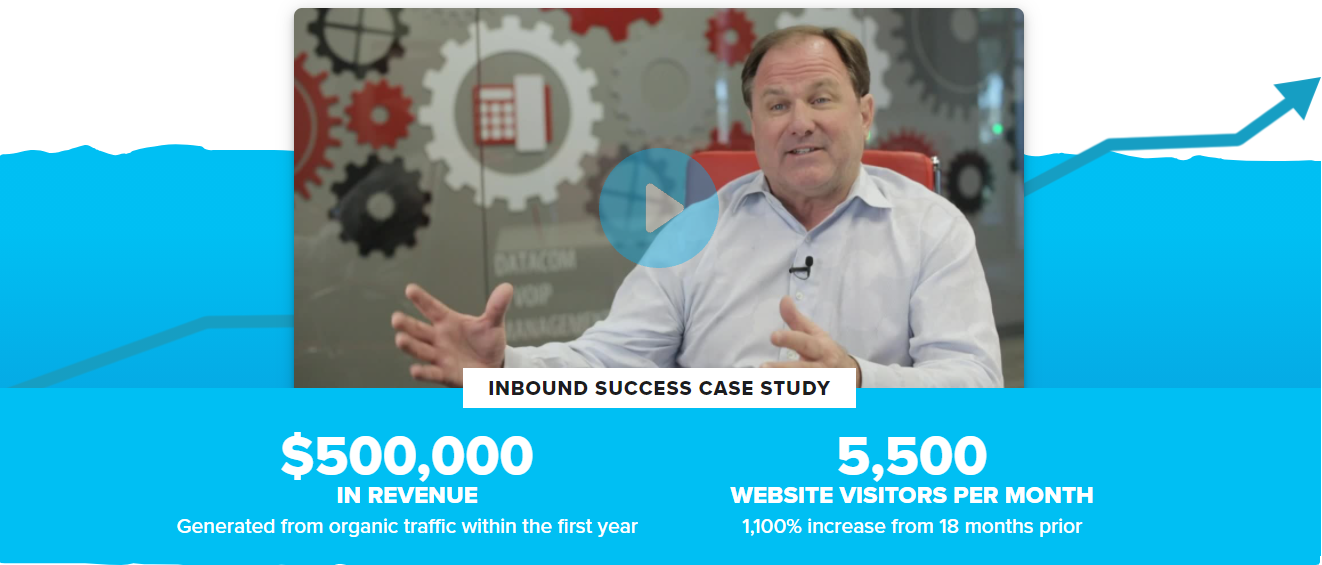
The use of out-of-date marketing strategies by B2B office IT vendors makes no sense. In terms of current marketing trends, outsourced IT service providers and copier rental firms are lagging, as are many other businesses.
An IT and leasing company in Las Vegas and southern California, AIS-NOW also sells copiers and printers and provides end-to-end solutions for local businesses.
The conventional ways of doing business had become tedious for them.
The Strategy
- Inbound marketing was important to AIS President Gary Houff, but he didn’t know how to put it into practice.
- As a result, Gary did what most other new inbound firms do: he hired a company to handle the work. The results were disappointing, as lead generation remained stagnant for 16 months despite hiring a HubSpot gold partner firm to help with their content marketing.
- AIS decided to try out in-house inbound marketing. That marketing team was led by the new Vice President of Marketing, Keven Ellison.
- In August 2019 in collaboration with IMPACT and HubSpot’s content and video consultant team, AIS began publishing two blog pieces and one video every week to address the most common queries around office technology.
- It was great to see traffic and leads increasing, but it was the increase in revenue that proved they were on the right course.
- The AIS team believes that inbound marketing platforms like HubSpot are critical to their success.
- To begin with, they opted to host their complete website on HubSpot’s CMS platform rather than just using HubSpot tracking tags for analytics and reporting.
- Keven appreciates HubSpot’s ability to improve the inbound marketing skills of his team.
- In the end, Keven believes HubSpot has played a critical role in helping him align the goals of his sales and marketing divisions.
- However, the biggest advantage is that they’ve taken care of everything on their own. To save money, they worked with experts who taught them how to execute inbound marketing instead of contracting out the task to a company.
The Success
- Month-over-month growth was virtually immediate for their web traffic, which had previously been flat. Over just 18 months, AIS’s organic website traffic surged by 11x, from 496 visits per month to 5,565, and the number of new leads jumped by 350%!
- In the first year of using this new strategy, they generated $500,000 in income from organic growth and 1,100% more website visitors than they had in the previous year.
Kaseya
Due to their GTM approach, Kaseya implemented Deduplication and Lead-to-Account Matching in their routing workflows.
Due to Kaseya’s ability to enable a land-and-expand go-to-market, their company’s acquisition strategy was able to be significantly accelerated.
Because they required the capability to support deliberate redundancies at the lead level before RingLead, they couldn’t set up procedures that let them sell into the same client from several business divisions. They couldn’t maximize their lead assignment because of the lack of an efficient routing system or data orchestration, which hindered their capacity to apply their GTM.
The Strategy
- With the help of RingLead’s all-in-one orchestration platform, Kaseya created several workflows to match leads to accounts, deduplicate leads, and route leads, they saved time and money while raising conversion rates.
- Deduplication and normalization were integrated into their routing to reduce lead responsiveness and promote CRM acceptance among previously unhappy sales reps.
- Include in their business the necessary region and account-based lead routing situations. They also had to route accounts based on whether they were parents or children.
- Before deduplication, Integrate applied lead-to-account matching and standardization using RingLead’s single-platform solution. Integration has been able to manage which parent or child accounts a lead is associated with and remove any unwanted redundancies by upgrading prospects with associated account data and normalizing.
- Sophisticated routing has been simplified using predefined jobs that may be customized to perform in different conditions. Integrate has increased their speed to lead times by a large margin because of better route efficiency as a result of orchestrating their data.
The Success
- There has been a huge increase in their rate of conversions.
- Sales reps no longer waste time on duplicates or poorly assigned leads, which saves them time and money.
- Using clever routing for speed and accuracy, they can keep hundreds of more leads each week.
- As a result of the lead being sent to the correct person, their follow-up time has been cut in half.
- Connecting new leads with current customer accounts is much easier, as is associating the account manager with that record and ensuring that the client connection will flourish.
Final Thoughts
When it comes to attracting B2B leads and expanding your customer base, nothing beats using inbound lead routing strategies. Which tactics you use will depend on a variety of circumstances, but implementing inbound lead routing properly will result in more and better leads for your organization.
